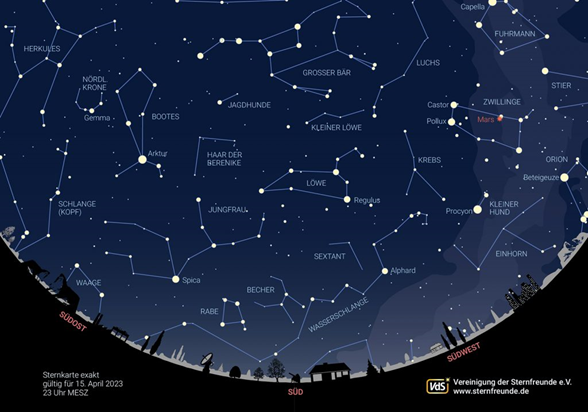The starry sky in April 2023
Since the equinox on March 26, the nights are getting shorter than the days again, so we are approaching the beautiful summer time again, but unfortunately also the "astronomical summer slump". The opening hours of the observatory on Friday evenings will therefore move to 9 p.m. CEST in April, assuming a cloudless night sky, of course.
Mercury in the evening sky, Venus and the Moon pass through the Golden Gate
SUN AND MOON
Sunset for Zweibrücken takes place on April 1 at 20:02 CEST, on April 15 at 20:23 and on April 30 at 20:45. Astronomically, things get interesting a good hour after sunset. The full moon on the morning of April 6 unfortunately clouds the view of the sky in the days before and after. On the evening of April 22, the narrow, waxing crescent moon moves through the so-called Golden Gate of the ecliptic (the apparent orbit of the sun around the earth), which runs between the Hyades (the celestial V) and the Pleiades.
PLANETS
Mercury offers the only chance of evening visibility of the year between April 3 and 13. It is located just above the western horizon at dusk, a few degrees to the north. Legend has it that the great astronomer Nicolaus Copernicus (1473-1543) lamented on his deathbed that he had never seen Mercury.
The Venus continues to develop as a radiant object in the evening sky after its rendezvous with Jupiter at the beginning of March. It is worth keeping an eye out for it above the western horizon at the beginning of twilight. On the nights of April 12 and 13, it moves through the Golden Gate of the ecliptic.
The heyday of the Marsmoving through the constellation Gemini is over.
Not to be observed are Jupiter, Saturn and Neptune. They have already set by the time dusk falls. Also Uranus cannot be well observed as it approaches the conjunction position in May.
STARRY SKY
On Northern sky the Great Bear swings up to the zenith. Due to the large horizon distance, this is a good opportunity to observe Messier 101, visually a difficult galaxy that requires dark skies and a good atmosphere. Cassiopeia and Cepheus descend to the NW. The inconspicuous dragon entwines the little bear with Polaris and turns its head towards Lyra which appears in the NE sky.
In the West the constellations of Aquarius, Gemini and Taurus are gradually approaching the horizon, while Orion is already in the process of setting.
High above us and against South are the constellations Leo and Ursa Major, as well as the striking asterism of the Big Dipper.
In the East the summer constellations of Hercules and Lyra with the striking star Vega slowly appear. The Swan rises slowly out of the haze.

